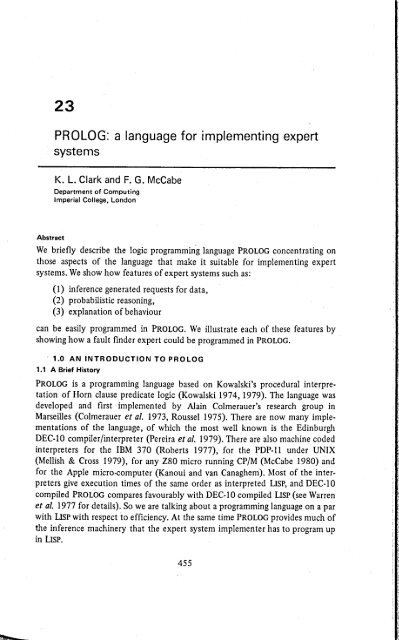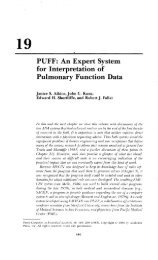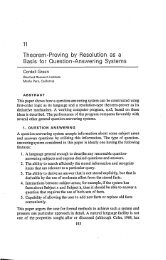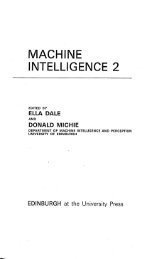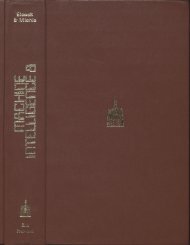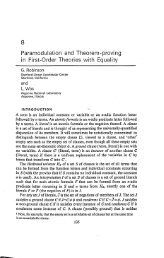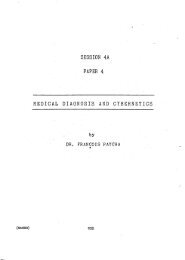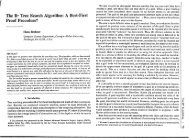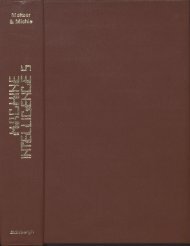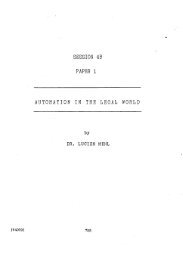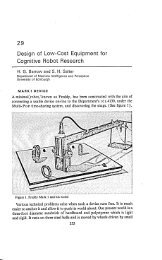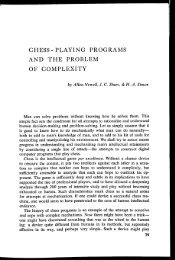PROLOG: a language for implementing expert systems - AITopics
PROLOG: a language for implementing expert systems - AITopics
PROLOG: a language for implementing expert systems - AITopics
Create successful ePaper yourself
Turn your PDF publications into a flip-book with our unique Google optimized e-Paper software.
23<br />
<strong>PROLOG</strong>: a <strong>language</strong> <strong>for</strong> <strong>implementing</strong> <strong>expert</strong><br />
<strong>systems</strong><br />
K. L. Clark and F. G. McCabe<br />
Department of Computing<br />
Imperial College, London<br />
Abstract<br />
We briefly describe the logic programming <strong>language</strong> <strong>PROLOG</strong> concentrating on<br />
those aspects of the <strong>language</strong> that make it suitable <strong>for</strong> <strong>implementing</strong> <strong>expert</strong><br />
<strong>systems</strong>. We show how features of <strong>expert</strong> <strong>systems</strong> such as:<br />
(1) inference generated requests <strong>for</strong> data,<br />
(2) probabilistic reasoning,<br />
(3) explanation of behaviour<br />
can be easily programmed in <strong>PROLOG</strong>. We illustrate each of these features by<br />
showing how a fault finder <strong>expert</strong> could be programmed in <strong>PROLOG</strong>.<br />
1.0 AN INTRODUCTION TO <strong>PROLOG</strong><br />
1.1 A Brief History<br />
<strong>PROLOG</strong> is a programming <strong>language</strong> based on Kowalski's procedural interpretation<br />
of Horn clause predicate logic (Kowalski 1974,1979). The <strong>language</strong> was<br />
developed and first implemented by Alain Colmerauer's research group in<br />
Marseilles (Colmerauer et al. 1973, Roussel 1975). There are now many implementations<br />
of the <strong>language</strong>, of which the most well known is the Edinburgh<br />
DEC-10 compiler/interpreter (Pereira et al. 1979). There are also machine coded<br />
interpreters <strong>for</strong> the IBM 370 (Roberts 1977), <strong>for</strong> the PDP-11 under UNIX<br />
(Mellish & Cross 1979), <strong>for</strong> any Z80 micro running CP/M (McCabe 1980) and<br />
<strong>for</strong> the Apple micro-computer (Kanoui and van Canaghem). Most of the interpreters<br />
give execution times of the same order as interpreted LISP, and DEC-10<br />
compiled <strong>PROLOG</strong> compares favourably with DEC-10 compiled LISP (see Warren<br />
et al. 1977 <strong>for</strong> details). So we are talking about a programming <strong>language</strong> on a par<br />
with LISP with respect to efficiency. At the same time <strong>PROLOG</strong> provides much of<br />
the inference machinery that the <strong>expert</strong> system implementer has to program up<br />
in LISP.<br />
455
LOGIC PROGRAMMING<br />
In Marseilles and Edinburgh <strong>PROLOG</strong> is the main Al programming <strong>language</strong>. In<br />
Marseilles its major use has been <strong>for</strong> natural <strong>language</strong> understanding (Colmerauer<br />
1978), but there was an early application to symbolic integration (Bergman &<br />
Kanoui 1973). In Edinburgh it has been used <strong>for</strong> plan <strong>for</strong>mation (Warren 1974,<br />
1976), problem solving (Bundy et al. 1979) and natural <strong>language</strong> understanding<br />
(Pereira 1980). It is also a handy <strong>language</strong> <strong>for</strong> compiler writing (Warren 1977).<br />
The DEC-10 <strong>PROLOG</strong> compiler is written in <strong>PROLOG</strong>.<br />
In Hungary, where there are several implementations of <strong>PROLOG</strong> (see<br />
Santane-Toth & Szeredi 1980), the <strong>language</strong> is widely used <strong>for</strong> <strong>implementing</strong><br />
<strong>expert</strong> <strong>systems</strong>. There are several concerning pharmacology: prediction of<br />
biological activity of peptides (Darvas et al. 1979), drug design aids (Darvas<br />
1978), prediction of drug interactions (Futo et al. 1978). It is also been used<br />
in architecture to aid the design of complexes of apartments from modular<br />
units (Markusz 1977) and <strong>for</strong> many other applications (see Santane-Toth &<br />
Szeredi 1980). Outside Hungary its use to develop <strong>expert</strong> <strong>systems</strong> has been slow<br />
to start. At Imperial College it has been used to build a small fault finder system<br />
(Hammond 1980). The authors intend to explore more fully the use of the Z80<br />
implementation <strong>for</strong> building desk-top <strong>expert</strong> <strong>systems</strong>. We also hope that this<br />
paper acts as a stimulus <strong>for</strong> others to use <strong>PROLOG</strong> to implement <strong>expert</strong> <strong>systems</strong>.<br />
12 <strong>PROLOG</strong> Program = A Set of Rules + A Data Base<br />
A <strong>PROLOG</strong> program comprises a sequence of clauses. The clauses are implications<br />
of the <strong>for</strong>m<br />
R(t1, . ,tn) if Al& &Ak,k >O.<br />
Each Al, like the R (tl, , tn), is a relation name R followed by a list of argument<br />
terms ti, , tn. A term is a constant, a variable, or a function name f followed<br />
by a list of argument terms, f(tl, ..,tn).<br />
The variable-free terms are the data structures of a logic program. Constants<br />
are like LISP atoms. A LISP list is a term such as cons(A, cons (B, Nil)), which can<br />
be written as A . B.C. Nil in infix notation, or as [A B C] in some <strong>PROLOG</strong>s.<br />
Different <strong>PROLOG</strong>s use different conventions to distinguish constants and<br />
variables. We shall use the convention that constants begin with an upper case<br />
letter (or are quoted), and that variables begin with a lower case letter.<br />
Declarative reading<br />
For the most part the clauses can be read as universally quantified implications,<br />
the quantification applying to all the variables of the clause. For example,<br />
fault (x, in (u, y)) if part (y, x) & fault (y,u)<br />
can be read as,<br />
<strong>for</strong> all x,y, u<br />
u my is a fault with x if y is part of x and u is a fault with y.<br />
456
Syntactic sugar<br />
CLARK AND McCABE<br />
Several of the <strong>PROLOG</strong>s allow the programmer to declare that certain predicate<br />
and function names will be written as operators with a particular precedence. By<br />
making "in", "is-fault-with" and "is-part-of" operators we can write the above<br />
clause as<br />
u my is-fault-with x if y is-part-of x & u is-fault-with y.<br />
This ability to extend the syntax with operators, or more generally to write a<br />
front-end program in <strong>PROLOG</strong> that accepts clauses written in any notation,<br />
makes it very easy to develop a user interface congenial to a specific use of<br />
<strong>PROLOG</strong>. A dramatic example of this is Colmerauer's use of the <strong>language</strong> <strong>for</strong><br />
natural <strong>language</strong> understanding. The <strong>PROLOG</strong> program <strong>for</strong> parsing some subset<br />
of natural <strong>language</strong> is written as a set of productions of his metamorphosis<br />
grammars.<br />
Assertions and rules<br />
The clauses with an empty antecedent, which are written without the if, are<br />
assertions. The set of all variable free assertions in a program can be thought of<br />
as the database of the program. The other clauses are the rules that will be used<br />
to interrogate and/or modify the data base.<br />
Queries<br />
A query is a conjunction of atoms Bl&...&Bn. It invokes a backward chaining<br />
use of the rules to interrogate the data base. The interrogation is successfully<br />
completed when a substitution s has been found such that [Bl& &Bi]s<br />
'follows from' the rules and the assertions. We have quoted 'follows from' since<br />
the substitution instance is not a logical consequence of the clauses viewed as<br />
assertions and implications when the data base of assertions has been modified<br />
during the interrogation. In <strong>expert</strong> <strong>systems</strong> applications we certainly want to be<br />
able to modify the data base, to accept new facts supplied by a user. If we are<br />
careful in the way we use the data base modifying facilities we can ensure that<br />
the Bl&. . .&Bn substitution instance is a logical consequence of the final state<br />
of the data base and the 'pure' rules of the program, the rules that do not<br />
modify the data base.<br />
As an example of a query evaluation let us suppose that the above rule<br />
about "is-fault-with" can access the assertions:<br />
Engine is-part-of Car<br />
Carburettor is-part-of Engine<br />
Dirt is-fault-with Carburettor<br />
The query<br />
y is-fault-with Car<br />
457
LOGIC PROGRAMMING<br />
can be answered by a backward chaining deduction that binds y to (Dirt in<br />
Carburettor in Engine). Notice how the nested 'in's' give us the path to the<br />
fault.<br />
Meta variable feature<br />
Just as LISP can evaluate a function named by a list structure, so a <strong>PROLOG</strong><br />
clause can use as a precondition an atom named by a term. This is usually<br />
referred to as the meta-variable feature since any clause that uses it can be<br />
thought of as an axiom schema. It means that we can write clauses of the <strong>for</strong>m<br />
, c) if .... &c&.<br />
in which a precondition is named by an argument term. We can think of the<br />
clause as an abbreviation <strong>for</strong><br />
R(...,P(xl, , xk)) if ....&P(xl, ..,xk)&..<br />
R(...,Q(yl, ..,yn)) if ....&Q(yl, ..,yn)&..<br />
in which there is a specific clause <strong>for</strong> each relation name used in the program.<br />
The "P(xl, xk)" appearing as a term is the name of the "P(xl, xk)"<br />
appearing as a precondition. This axiom schema explanation of the meta-variable<br />
feature is due to Philippe Roussel.<br />
1.3 Procedural Semantics<br />
An evaluation of the query Bl& ...&Bn is broken down into the evaluation of<br />
the query Bl, to find a substitution instance [BlIsl, followed by an evaluation<br />
of the query [B2&...VIOL The sl is a set of bindings <strong>for</strong> the variables of<br />
Bl which is passed on to the remaining conditions.<br />
The atomic query B1 will be of the <strong>for</strong>m R(tl, tn) <strong>for</strong> some predicate<br />
name R. It is answered by trying each of the clauses of the <strong>for</strong>m<br />
R(t'l, ,t'n) if Al& ..&Ak,<br />
until one is found that applies to find an instance of the query. It applies if there<br />
are substitutions s and s' <strong>for</strong> the variables of R(tl, tn) and R(t'l, .., en),<br />
respectively, that will make them syntactically identical. Technically, the two<br />
<strong>for</strong>mulae unify. All the <strong>PROLOG</strong>s use a simplified <strong>for</strong>m of Robinson's unification<br />
algorithm (see Robinson 1979) to test <strong>for</strong> unifiability. The algorithm returns a<br />
pair of substitutions s and s' when the test succeeds. These are most general<br />
substitutions in the sense that any other pair of unifying substitutions are<br />
essentially specialisations of s and s'. It is in this rule application by unification<br />
that much of the power of <strong>PROLOG</strong> resides.<br />
If k = 0, i.e. the program clause is an assertion, the evaluation of B1 is<br />
completed with s as the answer substitution. Otherwise the evaluation of B1<br />
reduces to the evaluation of the new query [A1&..&Ak]s'. The answer <strong>for</strong> Bl<br />
is then s modified by the answer substitution s" <strong>for</strong> this new query.<br />
458
CLARK AND McCABE<br />
An example evaluation<br />
The atomic query<br />
z is-fault-with Car<br />
can be solved using the program clause<br />
u my is-fault-with x if y is-part-of x & u is-fault-with y.<br />
Under the substitutions<br />
s = {z/u my)<br />
s' = {x/Car}<br />
z is-fault-with Car, u in y is-fault-with x<br />
become identical. The evaluation of the query reduces to the evaluation of the<br />
derived query<br />
y is-part-of Car & u is-fault-with y.<br />
With the assertions given above this will be solved with the answer<br />
s" = {y/Carburettor in Engine, u/Dirt}<br />
The answer to the original query is<br />
z/u in y where y/Carburettor in Engine and u/Dirt,<br />
i.e. it is z/Dirt in Carburettor in Engine. For more in<strong>for</strong>mation on the procedural<br />
semantics we refer the reader to Kowalski (1979).<br />
Backtracking<br />
The above recursively described evaluation process always takes the first program<br />
clause <strong>for</strong> which a matching substitution can be found. There may be other<br />
program clauses which could also be used. These will be tried should a subsequent<br />
evaluation step fail.<br />
A failure occurs when none of the program clauses will unify with the atomic<br />
query currently being attempted. When this happens the evaluation backtracks<br />
to the most recent previous evaluation step <strong>for</strong> which there are untried program<br />
clauses.<br />
Controlling the search<br />
The program clauses <strong>for</strong> a relation are always tried in the order in which they<br />
appear in the sequence of clauses. <strong>PROLOG</strong> programmers often exploit this order<br />
of use to give ordinary rules <strong>for</strong> a relation first, followed by a default rule that<br />
should only be used if the ordinary rules have failed. There is a backtracking<br />
control device, the "/", which can be used to prevent a later rule being used if an<br />
earlier rule has been successfully applied.<br />
For example, suppose that the rule<br />
B if Al& ..&AilAi+l& .& An<br />
459
LOGIC PROGRAMMING<br />
has been invoked to find an answer to an atomic query B'. If the preconditions<br />
,Ai that appear be<strong>for</strong>e the "I" can be solved then no later clause will be<br />
used to try to solve B'. The "I" expresses the control in<strong>for</strong>mation that the<br />
successful evaluation of Al to Al indicates that the later rules that might be used<br />
to solve B' will either fail or give the same answer. It also prevents backtracking<br />
on the proof of Al& . .<br />
2.0 FEATURES USEFUL FOR EXPERT SYSTEMS<br />
Inputs and updates<br />
During a query evaluation data can be input from a user, and assertions and rules<br />
can be added to the program, using special primitive relations. The evaluation of<br />
read(x) will cause x to be bound to the next term typed at the input terminal.<br />
The evaluation of assert(x) will cause the term which is the current binding of x<br />
to be added as a new rule. Thus, the rule<br />
Ask-about(c) if print (c, "") & read (ans)<br />
& ans = Yes & assert (c),<br />
used to try to answer the query,<br />
Ask-about (Dirt is-fault-with Carburettor),<br />
will print the message<br />
Dirt is-fault-with Carburettor,<br />
read the next term, and if it is the constant Yes it will add<br />
Dirt is-fault-with Carburettor<br />
as a new assertion about the is-fault-with relation. Where this assertion is added<br />
is important. It can be added at the beginning of the list of clauses <strong>for</strong> the<br />
relation, or the end, or at some intermediate position. In this situation we would<br />
like it added at the beginning. Where it is added is an option that can be specified<br />
by the programmer. We shall not go into the details of this.<br />
Dynamic data base<br />
The rule<br />
u my is-fault-with x if y is-part-of x & u is-fault-with y<br />
must access assertions giving components and assertions about faults with<br />
components. We can use the Ask-about rule to allow the assertions about faults<br />
to be added dynamically as we try to solve the problem of finding a fault.<br />
Instead of assertions about known faults with components we include in the<br />
initial data base only assertions about possible faults, knowledge that <strong>expert</strong><br />
should have. We then include the rule<br />
u is-a-fault-with y if u is-a-poss-fault-with y & Ask-about (u is-a-fault-with y)<br />
460
CLARK AND McCABE<br />
Let us pause <strong>for</strong> a moment to consider the behaviour of our fault finder. When<br />
asked to find a fault with some device with a query<br />
u is-fault-with Device<br />
the use of the first rule <strong>for</strong> faults will cause the fault finder to walk over the<br />
structure of Device as described by the is-part-of assertions. When it reaches an<br />
atomic part it will query the user concerning possible faults with this component<br />
as listed in the is-poss- fault-with assertions. It will continue in this way, backtracking<br />
up and down the structure, until a fault is reported. As it currently<br />
stands, our <strong>expert</strong> sytem helps the user to look <strong>for</strong> faults.<br />
Generation of lemmas<br />
Sometimes it is useful to record the successful evaluation of an atomic query B<br />
by adding its derived substitution instance as a new assertion. Thus, suppose we<br />
have a rule<br />
R(tL.. ,tn) if Al& . .&Ak<br />
and we want to generate a lemma each time it is successfully used to answer a<br />
query R(t' 1, , en). We add an extra assert condition at the end of the list of<br />
preconditions of the rule.<br />
R (tl, . . ,tn) if Al& . .&Ak & assert (R(tl, . . , tn))<br />
If this solves the atomic query with answer substitution s then [R , en*<br />
will be added as new assertion. It will be added at the front of the sequence of<br />
clauses <strong>for</strong> R.<br />
By adding asserts we can also simulate the use of rules with conjunctive<br />
consequences. Suppose that we know that both B and B' are implied by the<br />
conjunction Al& . &An. Normally we would just include the two rules:<br />
B if Al& . .&An<br />
B' if Al& . . &An<br />
in the program. The drawback is that we need to solve Al&..&An twice in<br />
derivations where both B and B' are needed. We can avoid the duplication by<br />
writing the two rules as:<br />
B if Al& ..&An&assert(B')<br />
B' if Al& . . &An &assert (B)<br />
The successful use of either rule will add the other consequent as a lemma.<br />
By developing a suitable front end to <strong>PROLOG</strong> we can shield the programmer<br />
from the details of the lemma generation. We could allow him to write rules with<br />
conjunctive consequents and to specify which rules were lemma generation rules.<br />
The front end program would expand rules with conjunctive consequents into<br />
several rules and add the appropriate asserts to the end of each of these rules.<br />
It would also add an assert to the end of eich of the lemma rules.<br />
461
LOGIC PROGRAMMING<br />
All solutions<br />
Sometimes we want to find all the answers to a query, not just one answer. This<br />
is an option in some of the <strong>PROLOG</strong>s. Where it is not we can make use of a metarule<br />
such as<br />
All (query, term) if query & print (term) & fail.<br />
This will print out [term]s <strong>for</strong> each answer substitution s to query. The "fail"<br />
is a condition <strong>for</strong> which we assume there are no clauses. With a slightly modified<br />
rule, we can define the relation<br />
/ is-all term such-that query<br />
that holds when I is the list of all the instantiations of "term" <strong>for</strong> answer substitutions<br />
to "query". In DEC-10 <strong>PROLOG</strong> such a relation is now a primitive of the<br />
<strong>language</strong>. Using it we can write rules such as<br />
I is-a-list-of-faults-with x if 1 is-all u such-that<br />
u is-fault-with x<br />
The use of this rule will result in 1 being bound to a list of all the faults with x.<br />
We can now consider a very simple extension to our fault finder. Instead of<br />
asking <strong>for</strong> a single fault we can ask <strong>for</strong> a list of all the reported faults with<br />
corrective actions. We do this with a query of the <strong>for</strong>m<br />
1 is-all [u a] such-that<br />
u is-fault-with D &a is-action-<strong>for</strong> u.<br />
To handle this query we must also include in our database a set of assertions<br />
giving actions <strong>for</strong> faults, in<strong>for</strong>mation supplied by the <strong>expert</strong>. An evaluation of<br />
this new query will guide the user through the structure of device D, asking<br />
about faults in components. Each reported fault will be paired with its corrective<br />
action. Finally the list of pairs [reported-fault corrective-action] will be<br />
printed.<br />
3.0 INEXACT REASONING<br />
MYCIN(Shortliffe 1976) and PROSPECTOR (Duda et al. 1979) use inexact or<br />
probabalistic reasoning. Probabilities are associated with assertions and rules.<br />
Conclusions are derived with associated probabilities. To implement this in<br />
<strong>PROLOG</strong> we augment all those relations about which we want to make probabilistic<br />
assertions with an extra argument. Instead of R(x,y) we use R(x,y,p).<br />
We read this as<br />
R (x,y) with certainty p.<br />
We now add to the rules that refer to these relations extra conditions to deal<br />
with the transfer of certainties from the preconditions to the conclusion.<br />
Let us elaborate our fault finder program to deal with uncertainties. To<br />
462
CLARK AND McCABE<br />
make it more of an <strong>expert</strong> we should have rules <strong>for</strong> detecting faults by their<br />
" symptoms. We should also allow that symptoms only partly correlate with faults.<br />
This means that the is-fault-with relation should have an extra argument to carry<br />
a certainty measure. We shall not go into details of what this is. Whatever measure<br />
is used must be handled by the probability transfer relations. The definition of<br />
these can implement whatever probability theory we choose.<br />
Instead of the rule that queries the user about possible faults we can now<br />
have the rule<br />
u is-fault-with x certainty p if<br />
s is-symptom-<strong>for</strong>-fault u of x strength q<br />
& s certainty r<br />
& q and r give p.<br />
This rule accesses assertions such as<br />
Stalling is-symptom-<strong>for</strong>-fault Dirt of Carburettor strength .3.<br />
The strength measure is the degree to which the symptom correlates with the<br />
fault. We also need assertions about the certainty of the symptoms, or more<br />
usefully, a rule such as<br />
u certainty r if print("Give the certainty of", u)<br />
& read (r) & assert (u certainty r)<br />
The rules <strong>for</strong> "q and r give p" implement our probability theory.<br />
When invoked by a query to find all the faults with some device our new<br />
probabilistic rule will query the user about the likely occurrence of each symptom<br />
that correlates with a fault in the device. It will use the user supplied certainty<br />
that the symptom is present, and the degree to which it correlates with the<br />
fault, to give a certainty <strong>for</strong> the associated fault.<br />
From single symptoms to sets of syndromes<br />
To compute a certainty <strong>for</strong> a fault on the basis of a single symptom is a little too<br />
simple. More realistically a fault will be signalled by one or other of several<br />
clusters of symptoms, that is, by one or other of several syndromes. A better<br />
version of our probabilistic is-fault-with rule is<br />
u is-fault-with x certainty p if<br />
1 is-all [sq] such-that<br />
s is-syndrome-<strong>for</strong> u of x strength q<br />
&lgives p.<br />
The rules <strong>for</strong> "1 gives p" must recurse down the list of syndrome-correlation<br />
pairs. In doing this it must compute the certainty of each syndrome using the<br />
certainties of the individual symptoms supplied by the user. It then computes a<br />
certainty <strong>for</strong> the fault using the certainties and strengths of all the syndromes.<br />
463
LOGIC PROGRAMMING<br />
A syndrome can be quite complex. The syndrome<br />
symptom Si and either symptom S2 or symptom S3 in the<br />
absence of symptom S4<br />
can be denoted by the term<br />
SI & (S2 or S 3) & not S4<br />
where "&", "or" & "not" are operators. To handle syndromes denoted by such<br />
terms the rules <strong>for</strong> computing the certainties of syndromes would look like:<br />
certainty-of-syndrome u is p if symptom(u) & u certainty p<br />
certainty-of-syndrome (u & v) is p if<br />
certainty-of-syndrome u is q<br />
& certainty-of-syndrome v is r<br />
& anding [q r] gives p<br />
The first rule deals with the case of a syndrome which is a symptom. The second<br />
deals with the case of one that is a conjunction of syndromes. The rules <strong>for</strong><br />
anding [q r] gives p<br />
compute the certainty of a conjunction of two syndromes given their individual<br />
certainties. How this is done is determined by the choice of probability theory.<br />
If we want to take into account such subtleties as dependencies between symptoms<br />
we would add an extra precondition<br />
dependency-of u and v is d<br />
to the rule and include d as an argument to the "anding" condition. We now also<br />
include in the data base assertions and rules about the interdependence of<br />
symptoms and syndromes.<br />
We would have analogous rules <strong>for</strong> the case of a "u or v" syndrome and the<br />
case of a "not u" syndrome.<br />
Symptom nets<br />
The set of alternative syndromes <strong>for</strong> a fault F in a component C will be described<br />
by a set of assertions of the <strong>for</strong>m<br />
(SI & (S2 or S3) & not S4) is-syndrome-<strong>for</strong> F of C strength Q.<br />
The set of all the assertions about a fault F are a description of a symptom net<br />
<strong>for</strong> F as depicted in Fig. 1.<br />
This is just a shallow inference net. The movement of probabilities along the arcs<br />
of this is a special case of what PROSPECTOR does.<br />
464
CLARK AND McCABE<br />
\<br />
1<br />
1, syndrome 2 ;<br />
■<br />
Fig. 1.<br />
A prototype general fault finder<br />
Let us conclude this section of probabilistic inference by examining the state of<br />
our <strong>PROLOG</strong> fault finder. The three rules:<br />
u in y is-fault-with x certainty p if y is-part-of x<br />
& u is-fault-with y certainty p<br />
u is-fault-with x certainty p if<br />
1 is-all [sq] such-that<br />
s is-syndrome-<strong>for</strong> u of x strength q<br />
& 1 gives p<br />
help(s, /) if 1 is-all [u a pi such-that<br />
u is-fault-with s certainty p<br />
& a is-action-<strong>for</strong> u,<br />
together with the rules that implement the probability theory, <strong>for</strong>m the nucleus<br />
of a general fault finder. To use this fault finder program we<br />
(1) add a set of "is-part-of" assertions giving the structure of a new device<br />
about which we want help in finding faults,<br />
(2) add a set of assertions giving the correlation of syndromes with faults in<br />
atomic components,<br />
(3) add a set of assertions giving the appropriate action <strong>for</strong> each fault.<br />
The sets of assertions (1), (2) and (3) are what the <strong>expert</strong> provides. It is the<br />
way that he 'programs' the fault finder.<br />
465
LOGIC PROGRAMMING<br />
A user of the fault finder asks <strong>for</strong> help in mending some substructure S of<br />
the device with the query help(S,/). He waits to be asked about the certainty of<br />
occurrence of various symptoms. He will have printed out a list of possible faults<br />
together with the corrective action. Each fault will be described by a path name<br />
to its position in S. It will be listed with a likelihood of its presence.<br />
4.0 EXPLAINING<br />
One of the most important abilities of an <strong>expert</strong> system is to be able to explain<br />
itself to a user in intelligible terms. If an <strong>expert</strong> system produces a fault diagnosis<br />
of a car, or an analysis of a chemical compound, the user needs to be convinced<br />
that the result is reasonable; that it has not been pulled out of the hat. So an<br />
<strong>expert</strong> system should be able to give an account of how it reaches its conclusions.<br />
Moreover, no <strong>expert</strong> system produces its answers without some data, which<br />
is usually supplied by the user when prompted by the system. It is reasonable<br />
<strong>for</strong> the user to be able to ask why the data is being requested.<br />
There are, then, two kinds of explaining <strong>for</strong> an <strong>expert</strong> system, the "HOW"<br />
and the "WHY". Let us look at one way in which a set of <strong>PROLOG</strong> clauses can be<br />
modified to cope with these two kinds of explaining.<br />
WHY explanations<br />
Consider again the non-probabilistic version of the <strong>PROLOG</strong> fault finder. Let us<br />
suppose that we want to allow the user to ask why he is being asked if there is<br />
some particular fault with a component. To be able to respond to such a "WHY"<br />
request the ask-about rule must have access to the context in which it is invoked.<br />
One way in which we can do this is to pass a description of the context as an<br />
extra argument to each rule that might ultimately lead to the use of the Ask-about<br />
rule. For example, instead of the rule<br />
u is-fault-with x if u is-poss-fault-with x &<br />
ask-about (u is-fault-with x)<br />
which we shall call rule 2, we could use<br />
u is-problem-with x trace t<br />
if u is-poss-fault-with x &<br />
Ask-about (u is-fault-with x,<br />
2: [u is-poss-fault-with x] . t).<br />
The 2: [u is-poss-fault-with x] added to the front of the current trace t tells us<br />
that rule 2 has been invoked and that its precondition (u is-poss-fault-with x)<br />
is satisfied. Similarly, we could modify rule<br />
u in y is-fault-with x if y is-part-of x & u is-fault-with y,<br />
called rule 1, to the rule<br />
u in y is-fault-with x trace t<br />
if u is-part-of x &<br />
u is-fault-with x trace 1: [u is-part-of x] • t<br />
466
CLARK AND McCABE<br />
This adds the fact that rule 1 is being used to the front of the trace and records<br />
the single precondition of the rule that is currently satisfied.<br />
The Ask-about rules now need modification to:<br />
Ask-about (c, t) if print (c, "") & read (ans) & respond (ans, c, t)<br />
respond (Yes, c, t) if assert(c)<br />
respond (Why, c,u.t) if give-reason (u) & Ask-about (c, t)<br />
respond (Why, c, Nil) if print ("you should know")<br />
& Ask-about (c, Nil).<br />
The new Ask-about will pick off an explanation u from the trace list <strong>for</strong> each<br />
"Why" repsonse and display it. The rules <strong>for</strong> give-reason might access a set of<br />
assertions of the <strong>for</strong>m<br />
description(n, "some text describing rule n")<br />
in order to give a meaningful description of the rule mentioned in u. Each repeated<br />
"Why" leads to a more distant reason <strong>for</strong> the question being printed out by the<br />
give-reason rules. Finally:when the trace is empty, we are back at the top-level<br />
query. A "Why" at this point gets the response "you should know" followed<br />
by a new prompt.<br />
As an example of the use of these new rules, let us suppose that in solving<br />
the query<br />
u is-fault-with Car trace Nil<br />
rule 1 has been used twice because of the assertions<br />
Engine is-part-of Car<br />
Carburettor is-part-of Engine,<br />
and then rule 2 has been used. It has accessed the assertion<br />
Blocked-valve is-poss-fault-with Carburettor<br />
and is now querying the user about this fault. The trace argument passed to<br />
Ask-about is<br />
2 : [Blocked-valve is-poss-fault-with Carburettor].<br />
1: [Carburettor is-part-of Engine].<br />
1: [Engine is-part-of Car] .Nil<br />
Rule trans<strong>for</strong>mation<br />
As with lemma generation the modification of the clauses to cater <strong>for</strong> "Why"<br />
explanations can be per<strong>for</strong>med by a front end program. The input to this program<br />
would be numbered rules without the trace argument. Along with this program<br />
would be a set of directives which specified which rules should be traced and<br />
which relations are such that their proofs might lead to the use of "Ask-about".<br />
We are assuming that "Ask-about" is being used as though it were a primitive<br />
467
LOGIC PROGRAMMING<br />
predicate. The programmer would also include a set of assertions describing the<br />
explainable rules. The front end program rewrites the designated rules to include<br />
the trace argument.<br />
The rewrite is quite straight<strong>for</strong>ward. Suppose we have a rule of the <strong>for</strong>m<br />
Rule k: R(tl, , tn) if Al& . .&Ai &P(t'l,<br />
that must be traced. Let us also suppose that P is a relation the proof of which<br />
can lead to the use of the Ask-about rules. We must trans<strong>for</strong>m the rule into<br />
Rule k:<br />
R(tl, ..tn,t) if A l& . &Ai &P(el,<br />
The rule passes down to the rules <strong>for</strong> P the current trace extended by a message<br />
to the effect that rule k has been used. The list of terms [Al, . , Ai] that is also<br />
passed down will be the preconditions Al, ,Ai instantiated by any substitution<br />
generated by the proof of this conjunction of conditions. It tells us exactly what<br />
the state of play is in the application of this rule.<br />
How explanations<br />
We can use the same extra argument trick to save proofs. We can also hide it<br />
from the <strong>expert</strong> system programmer. He simply states that certain relations should<br />
be proof traced, these being the relations that he wants mentioned in the "How"<br />
explanations. The front end program then trans<strong>for</strong>ms the clauses <strong>for</strong> these<br />
relations as follows.<br />
An assertion<br />
P(tl, ,tn)<br />
becomes<br />
P(tl, ..,tn, P(tl, ..,tn))<br />
The extra argument is the trace of the proof of the instance of P found using the<br />
assertion. It will be a copy of the proven instance.<br />
A rule of the <strong>for</strong>m<br />
P(tl, , tn) if . . &Q( .)& ...&R(..)&.. ,<br />
in which Q and R are the only proof trace relations in the antecedent, is trans<strong>for</strong>med<br />
into<br />
P(tl, ..,tn, proof 1 & proof 2 implies P(tl, ..,tn)) if<br />
. .&Q(.., proof 1) & . . . &R(.., proof 2) &<br />
This constructs a description of the proof of the instance of P that it generates in<br />
terms of the descriptions of the proof trace relations that it accesses. If this rule<br />
is also declared a lemma generating rule we can trans<strong>for</strong>m it into<br />
P(tl, , tn,P(tl, ..,tn)) if<br />
. .&Q(. , proof 1) & . . . .&R(..,proof2)&<br />
& assert(proofl &proof2 implies P(tl, , tn))<br />
& assert(P(tl, , tn))<br />
468
CLARK AND McCABE<br />
This asserts the explanation as well as the lemma. The proof trace returned is a<br />
reference to this lemma.<br />
The following rule now defines a relation that the user can invoke to seek an<br />
explanation of some asserted lemmaP(tl, tn) with a query Explain (P(tl, ,tn)).<br />
Explain (lemma) if proof implies lemma & display (proof)<br />
This retrieves the term that describes the proof of the lemma from the "implies"<br />
assertion <strong>for</strong> the lemma and then displays it in a suitable <strong>for</strong>mat. The explanation<br />
will be a proof structure down to other asserted lemmas. If the user wants to see<br />
more he asks <strong>for</strong> an explanation of these other lemmas.<br />
5.0 CONCLUSIONS<br />
We hope that we have convinced the potential <strong>expert</strong> system implementer that<br />
he should look at <strong>PROLOG</strong> more closely. We do not claim that the techniques <strong>for</strong><br />
programming <strong>expert</strong> <strong>systems</strong> that we have sketched are the best. They represent<br />
just one possibility. A fully fledged implementation of our fault finder would<br />
undoubtedly reveal shortcomings. Nonetheless we are convinced that <strong>PROLOG</strong><br />
offers a programming medium in which these could be easily overcome. We<br />
invite the reader to do his own experimenting with <strong>PROLOG</strong>.<br />
6.0 ACKNOWLEDGEMENTS<br />
The main ideas in this paper evolved through discussions with P. Hammond. Our<br />
fault finder example was inspired by his <strong>PROLOG</strong> fault finder, although he tackles<br />
the problem in a slightly different way.<br />
The paper was written whilst Keith Clark was visiting Syracuse university.<br />
Comments on the ideas by K. Bowen, J. A. Robinson and E. Sibert were much<br />
appreciated.<br />
We would also like to thank Diane Zimmerman. She patiently typed the<br />
paper into a text <strong>for</strong>matter using an often overloaded computer system.<br />
7.0 REFERENCES<br />
Bergman, M., Kanoui, H. (1973), Application of mechanical theorem proving to symbolic<br />
calculus, 3rd Int. Symp. on Adv. Methods in Physics, C.N.R.S., Marseilles.<br />
Bundy, A., Byrd, L., Luger, G., Mellish, C., Palmer, M., (1979), Solving mechanics problems<br />
using meta-level inference, Expert <strong>systems</strong> in Micro Electronic Age, pp. 50-64 (ed.<br />
Michie, D.). Edinburgh: Edinburgh University Press.<br />
Colmerauer, A., Kanoui, H., Pasero, R., Roussel, P. (1973), Un systeme de communication<br />
homme-machine en francais. Rapport, Groupe d'Intelligence Artificielle, Marseille:<br />
Univ. d'Aix, Luminy.<br />
Colmerauer, A. (1978), Metamorphosis Grammars. Natural <strong>language</strong> communication with<br />
computers, pp. 133-189 (ed. Bolc, L.) Lect. Notes in Comp. Sci. No. 63, Springer<br />
Verlag.<br />
Darvas, F., (1978), Computer analysis of the relationship between biological effect and<br />
chemical structure. Kemiai Kozlemenyek, 50, (Hungarian).<br />
Darvas, F., Lopata, A., Gy. Matrai, (1979), A specific QSAR model <strong>for</strong> peptides. In<br />
Quantitative Structure Activity Analysis, (ed. Darvas, F.), Budapest: Akademiai Kiado.<br />
469
LOGIC PROGRAMMING<br />
Duda, R., Gashnig, J., Hart, P., (1979), Model design in the prospector consultant system<br />
<strong>for</strong> mineral exploration, Expert Systems in the Micro Electronic Age, pp. 153-167<br />
(ed. Michie, D.). Edinburgh: Edinburgh University Press.<br />
Futo, I., Darvas, F., Szeredi, P., (1978), Application of <strong>PROLOG</strong> to development of QA and<br />
DBM <strong>systems</strong>, Logic and Data Bases, (ed. Gallaire, H. and Minker, J.). Plenum Press.<br />
Hammond, P. (1980), Logic programming <strong>for</strong> <strong>expert</strong> <strong>systems</strong>, MSc Thesis, London: Imperial<br />
College, University of London.<br />
Kanoui, van Caneghem, (1980), Implementing a very high level <strong>language</strong> on a very low cost<br />
machine, Rapport, Marseille: Group d'Intelligence Artificielle, University d'Aix-<br />
Marseille, Luminy.<br />
Kowalski, R. (1974), Predicate logic as programming <strong>language</strong>, Proceedings IFIP 74.<br />
Kowalski, R. (1979), Logic <strong>for</strong> problem solving, Amsterdam and New York: North Holland.<br />
McCabe, F. G. (1980). Micro-<strong>PROLOG</strong> programmers reference manual, 36 Gorst Rd.,<br />
London: LPA Ltd.<br />
Markusz, Z. (1977), How to design variants of flats using programming <strong>language</strong> <strong>PROLOG</strong>,<br />
based on mathematical logic, Proc. In<strong>for</strong>mation Processing 77, pp. 885-889 (ed.<br />
Gucheist, B.) Amsterdam, New York, Ox<strong>for</strong>d: North Holland.<br />
Pereira, L., Pereira, F., Warren, D., (1978), User's guide to DEC-system 10 <strong>PROLOG</strong>,<br />
Edinburgh: Dept. of A.I., Edinburgh University.<br />
Pereira, F. (1980), Extraposition grammars, Proceedings of Logic Programming Workshop,<br />
(Budapest).<br />
Roberts, G. M. (1977). An implementation of <strong>PROLOG</strong>, M.Sc. Thesis, Waterloo: Dept. of<br />
Computer Science, University of Waterloo, Canada.<br />
Robinson, J. (1979), Logic: Form and Function, Edinburgh: Edinburgh University Press.<br />
Roussel, P. (1975), <strong>PROLOG</strong>, Manuel de Reference et d'Utilisation, Marseille: Groupe<br />
d'Intelligence Artificielle, U.E.R. de Luminy, University d'Aix.<br />
Shortliffe, E. H. (1976). Computer Based Medical Consultations: MYCIN, America! Elsevier,<br />
New York.<br />
Santane-Toth, E., Szeredi, P., (1981), <strong>PROLOG</strong> applications in Hungary, In Logic Programming<br />
(eds. Clark, K. L. and McCabe, F. G.), London: Academic Press.<br />
Warren, D., Pereira, L., Pereira, F. (1977), <strong>PROLOG</strong> - the <strong>language</strong> and its implementation<br />
compared with LISP, Proc. Symp. on Al and Frog, <strong>language</strong>s, SIGPLAN notices, 12,<br />
No. 18.<br />
Warren, D. (1974), WARPLAN: A system <strong>for</strong> generating plans, Memo, Dept. of A.I., Edin.<br />
Univ. •<br />
Warren, D. (1976), Generating conditional plans and programs, Proc. AISB Summer Conference,<br />
(Edinburgh).<br />
Warren, D. (1977), Logic programming and compiler writing, Report, Edinburgh: A.I. Dept.,<br />
Edinburgh University.<br />
470
Appendix to <strong>PROLOG</strong>: a <strong>language</strong> <strong>for</strong><br />
<strong>implementing</strong> <strong>expert</strong> <strong>systems</strong><br />
P. Hammond<br />
Department of Computing<br />
Imperial College, London<br />
INTRODUCTION<br />
An <strong>expert</strong> system, which is domain-independent, has been implemented in Micro-<br />
<strong>PROLOG</strong>* with many of the features described above. It interacts with a knowledge-base<br />
and a set of rules <strong>for</strong> handling uncertianty to become a domain <strong>expert</strong>.<br />
The facilities that have been built into the system include the following:<br />
(i) the handling of degrees of belief in evidence and their subsequent effect<br />
on related deductions;<br />
(ii) the explanations of why a particular question is being asked and how a<br />
deduction has been made;<br />
(iii) the use of key symptoms to direct the problem-solving activity to a<br />
narrower solution set;<br />
(iv) the ability <strong>for</strong> the user to query the knowledge-base as a database, e.g.,<br />
to see the rules;<br />
(v) the inclusion of symptoms that have values e.g., age and temperature;<br />
(vi) the use of external files to store relations to avoid loading the entire<br />
knowledge base into machine memory.<br />
CHANGES IN THE DATA REPRESENTATION AND METHODOLOGY<br />
The system has been used with knowledge-bases on car fault-finding, skin disease<br />
diagnosis, ant identification, personal investment analysis and pipe corrosion<br />
diagnosis.<br />
To accommodate such a wide range of use, which goes beyond simple faultfinding<br />
in a structured object, the knowledge representation framework was<br />
generalised so that each application is just a special case of a more general<br />
scheme. For example, the "part of" structure of the fault finder has now become<br />
a partition of the solution space into a collection of nested subsets rather like<br />
the taxonomical divisions used in botany and zoology. In fact, the ants data-base<br />
471
LOGIC PROGRAMMING<br />
is a good example of this subclassification process. The following diagram<br />
illustrates the divisions of a collection of British ants into sub-family, genus and<br />
species:<br />
ant<br />
MYRMICINAE<br />
FORMICINAE<br />
Sub-family<br />
Myrmica Leptothorax Lasius Formica<br />
lobicornis fuliginosus niger rufa<br />
genus<br />
species<br />
Now, instead of having one complex syndrome <strong>for</strong> indentifying "fuliginosus"<br />
such as<br />
Deduction<br />
fuliginosus in ants<br />
Syndrome s<br />
number of waist segments is 1 &<br />
leg-length is short &<br />
colour is black &<br />
head-shape is heart-like.<br />
we can define a hierarchy of rules corresponding to the partition above:<br />
Deduction<br />
MYRMICINAE in ants<br />
FORMICINAE in ants<br />
Lasius in FORMICINAE<br />
Formica in FORMICINAE<br />
fuliginosus in Lasius<br />
niger in Lasius<br />
Sydrome<br />
number of waist segments is 2<br />
number of waist segments is 1<br />
leg-length is short<br />
leg-length is long<br />
colour is black &<br />
head-shape is heart-like<br />
colour is black &<br />
head-shape is normal<br />
Thus the rules <strong>for</strong> differentiating within Lasius are only tested if we have established<br />
the syndrome in the rule <strong>for</strong> identifying Lasius in FORMICINAE.<br />
To illustrate how this division applies to the familiar fault finder consider<br />
the following:<br />
car<br />
engine<br />
cooling-system<br />
starter motor<br />
plugs<br />
fan-belt<br />
radiator<br />
overhaul-needed<br />
jamming<br />
wrong-gap<br />
slackness<br />
leak<br />
472
HAMMOND<br />
This tree reflects a fault classification scheme where faults are associated with<br />
each group of components. Rather than simply reflecting the construction of the<br />
car it describes how faults are associated with assemblies and sub-assemblies of<br />
components. For example, "cooling-system" now stands <strong>for</strong> the class of coolingsystem<br />
faults.<br />
INEXACT REASONING<br />
We have developed two modules <strong>for</strong> handling inexact reasoning. One uses MYCINlike<br />
and the other PROSPECTOR-like (or BAYESIAN-like) uncertainty. The<br />
designer of the knowledge-base can decide which method to use, without affecting<br />
the kernal of the <strong>expert</strong> system or the <strong>for</strong>m of the data-base. Of course each<br />
scheme has its own requirements; the MYCIN method has a single number<br />
<strong>for</strong> each rule that describes a syndrome-deduction correlation whereas the<br />
PROSPECTOR method involves two such numbers. The possibility also exists<br />
<strong>for</strong> the <strong>expert</strong> to define his own method of handling uncertainty.<br />
The pipe corrosion data-base uses the BAYESIAN-like uncertainty and each<br />
of the other data-bases uses MYCIN-like uncertainty. Some ef<strong>for</strong>t is being made<br />
by the authors to find a satisfactory way of handling dependency between<br />
symptoms.<br />
KEY-SYMPTOMS<br />
An <strong>expert</strong> frequently makes use of key symptoms to focus attention on a subclass<br />
of problems. To aid this important process the <strong>PROLOG</strong> classifier allows the<br />
knowledge-base constructor to declare certain key symptoms that can be used to<br />
concentrate on a particular subclass in the "sub-class" hierarchy. For example,<br />
we could declare "number-of-waist-segments", "colour" etc. as key symptoms<br />
and define the following:<br />
number-of-waist-segments is 1<br />
colour in-list (black yellow)<br />
high-petrol-consumption<br />
high-petrol-consumption<br />
engine-fails-to-start<br />
suggests-check<br />
suggests-check<br />
suggests-check<br />
suggests-check<br />
suggests-check<br />
class MYRMICINAE<br />
class Lasius<br />
class carburettor<br />
identification<br />
leak in fuel-system<br />
class battery<br />
These key symptoms will be requested at the beginning of a consultation. Those<br />
that are reported cause the classifier to check the suggested areas.<br />
SYSTEM ARCHITECTURE<br />
The figure above gives a simple-minded view of the structure of the classifier<br />
with particular reference to the flow of in<strong>for</strong>mation between the user, the core<br />
program and the knowledge-base. Once the user has indicated which knowledgebase<br />
is to be consulted, the core program is able to infer from the rule structure<br />
(see under INEXACT REASONING above) which method of handling uncertainty<br />
is appropriate.<br />
473
LOGIC PROGRAMMING<br />
This diagram is also useful in explaining how the system reacts to special<br />
responses from the user. For example, we have already indicated that the response<br />
"why" causes the system to re-trace the history of the consultation to explain<br />
its current line of reasoning. This is handled within the core program by the<br />
assertion<br />
needs-response (why)<br />
and a set of general rules <strong>for</strong> the re-tracing. If a user wishes to alter the <strong>for</strong>m of<br />
the explanantion to make it more domain-specific, he need only re-define the<br />
general rules to his own liking and include them in the knowledge-base. Similarly,<br />
other responses to handle special queries to the knowledge-base can be defined<br />
by assertions of the <strong>for</strong>m<br />
needs-response (deductions) , needs-response (help)<br />
along with rules which print the deductions that can be made or which explain<br />
the help facilities which are available.<br />
SYMPTOMS THAT HAVE VALUES<br />
Already from the examples above we have illustrated a fair degree of freedom<br />
in symptom description. Currently the system can recognise symptoms which<br />
are of the following types:<br />
(i) mnemonic-like strings such as engine-wont-start;<br />
(ii) (name) (relation) (value)<br />
where (relation) is a pre-defined binary relation between possible values<br />
of (name) and (value); <strong>for</strong> example<br />
age in-range (20 to 40)<br />
colour in-list (red yellow)<br />
height LESS 40<br />
size is 10<br />
EXTERNALLY DEFINED RELATIONS<br />
The system has so far been used on Z80 based microcomputers with small internal<br />
memory (56 to 64k). As knowledge-bases have grown it has become necessary<br />
to store parts of the data in backing store on disc. The system can then access<br />
this in<strong>for</strong>mation as the need arises. Another use of this facility would be to<br />
access data-bases related to the knowledge area.<br />
FUTURE DEVELOPMENTS<br />
The work with <strong>expert</strong>s in skin problem diagnosis and pipe corrosion is continuing<br />
and it is hoped that these databases will become more realistic as more detailed<br />
knowledge is added. Other collaboration with industry is being set up and plans<br />
have already been made to implement the classifier on more powerful computers,<br />
such as the PERQ, and to experiment with the uses of computer graphics.<br />
474
IIAMMOND<br />
The construction of knowledge bases which can interface with the <strong>PROLOG</strong><br />
classifier was part of a recent MSc thesis by M. Y. Chin (1981) at Imperial<br />
College. This project also illustrated how the classifier could be used <strong>for</strong> structured<br />
questionnaires.<br />
The use of quasi-natural <strong>language</strong> <strong>for</strong> <strong>expert</strong> <strong>systems</strong> has been investigated<br />
by another recent M.Sc. student at Imperial College (Steele 1981). The knowledge<br />
representation and problem-solving strategy used in this project illustrate alternatives<br />
to that used in our general purpose classifier.<br />
REFERENCES<br />
M. Y. Chin (1981), Computer Interrogation Systems: CISP, M.Sc. thesis, London: Department<br />
of Computing, Imperial College.<br />
F. G. McCabe (1981), Micro-<strong>PROLOG</strong> Progammer's Reference Manual, L.P.A. Ltd., 36<br />
Gorst Road, London SW11.<br />
B. D. Steele (1981), EXPERT — The implementation of data-independent <strong>expert</strong> <strong>systems</strong><br />
with quasi-natural <strong>language</strong> in<strong>for</strong>mation input, M.Sc. thesis, London: Department of<br />
Computing, Imperial College.<br />
475


